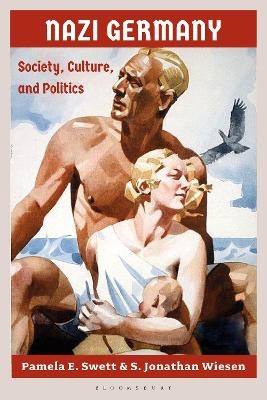
Nazi Germany
Bloomsbury Academic (Verlag)
978-1-350-11261-2 (ISBN)
The book unravels the complexities of the daily lives of perpetrators, victims, and bystanders in the ‘Third Reich’, and it also places events in Germany from 1933 to 1945 in a transnational context. Nazi Germany prompts readers to think about not only the historical debates but also the ethical questions that attend the study of this period. Pamela E. Swett and S. Jonathan Wiesen address:
*The movement’s ideological origins and the party’s rise to power
*The creation of a police state, the use of propaganda, and public support for Nazi ideas and programs
*The Nazis’ persecution of religious, racial, and sexual minorities
*The place of youth, family, gender, and cultural expression in Nazi society
*The transnational influence of Nazism and preparations for war in Germany
*The Holocaust, resistance to Nazism, and the Second World War
Swett and Wiesen explore how the violence and racism of the Nazis coexisted alongside Germany’s self-presentation as a ‘normal’ state with happy, productive citizens.Through exposure to the voices of contemporaries, readers will be prompted to consider key questions: How did German democracy give way to a brutal dictatorship so quickly? What was daily life like for ‘average’ Germans and those labeled as biological and political outsiders? Why did the Nazi dictatorship embark on a destructive war that led to the death of tens of millions of Europeans and to the demise of a political order that had become exceedingly popular by 1939?
Pamela E. Swett is Professor of History and Dean of the Faculty of Humanities at McMaster University, Canada. She is the author of Neighbors and Enemies: The Culture of Radicalism in Weimar Berlin, 1929-1933 (2004) and Selling under the Swastika: Advertising and Commercial Culture in Nazi Germany (2014). She is also the co-editor, along with S. Jonathan Wiesen and Jonathan Zatlin, of Selling Modernity: Advertising in Twentieth Century Germany (2007), as well as Pleasure and Power in Nazi Germany (2011), alongside Corey Ross, and Reshaping Capitalism in Weimar and Nazi Germany (2022), with Moritz Föllmer. S. Jonathan Wiesen is Professor of History and Department Chair at the University of Alabama at Birmingham, USA. He is the author of West German Industry and the Challenge of the Nazi Past, 1945-1955 (2001), which won the Hagley Prize in Business History, and Creating the Nazi Marketplace: Commerce and Consumption in the Third Reich (2011). He is also the co-editor, along with Pamela Swett and Jonathan Zatlin, of Selling Modernity: Advertising in Twentieth Century Germany (2007). Wiesen and Swett also co-edited the Nazi era chapters of the German Historical Institute’s Historical Documents and Images online portal, for which they added hundreds of new documents, maps, tables, sound clips, still images, and moving images.
List of Images
List of Maps and Charts
Introduction
1 The German Reich, Weimar, and the Birth of National Socialism
2 The National Socialist Rise to Power
3 Consolidating the Nazi Regime and Building a Police State
4 Racism and Biopolitics
5 Economy and Society
6 Arts and Culture
7 Youth, Gender, and Sexuality
8 Nazi Germany and the World
9 War and Empire, 1939–42
10 The Holocaust
11 Resistance and Rescue
12 Defeat, 1943–5
Select Bibliography
Index
| Erscheinungsdatum | 16.08.2024 |
|---|---|
| Zusatzinfo | 3 Maps |
| Verlagsort | London |
| Sprache | englisch |
| Maße | 156 x 234 mm |
| Themenwelt | Geschichte ► Allgemeine Geschichte ► Neuzeit (bis 1918) |
| Geschichte ► Allgemeine Geschichte ► 1918 bis 1945 | |
| Geisteswissenschaften ► Geschichte ► Regional- / Ländergeschichte | |
| Geschichte ► Teilgebiete der Geschichte ► Militärgeschichte | |
| ISBN-10 | 1-350-11261-5 / 1350112615 |
| ISBN-13 | 978-1-350-11261-2 / 9781350112612 |
| Zustand | Neuware |
| Haben Sie eine Frage zum Produkt? |
aus dem Bereich


